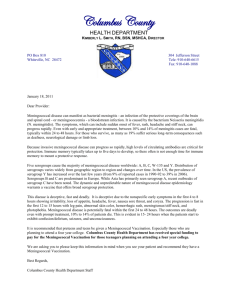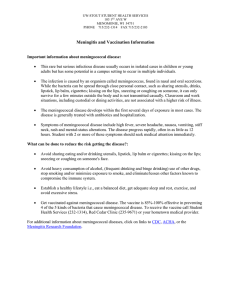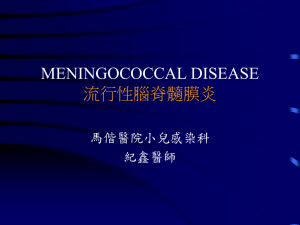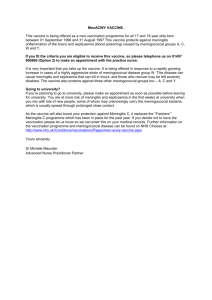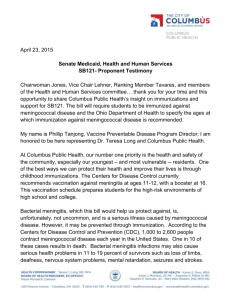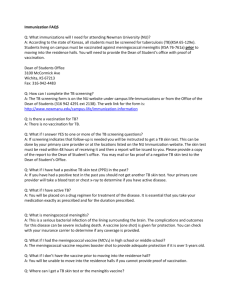Overview of Meningococcal Meningitis
advertisement
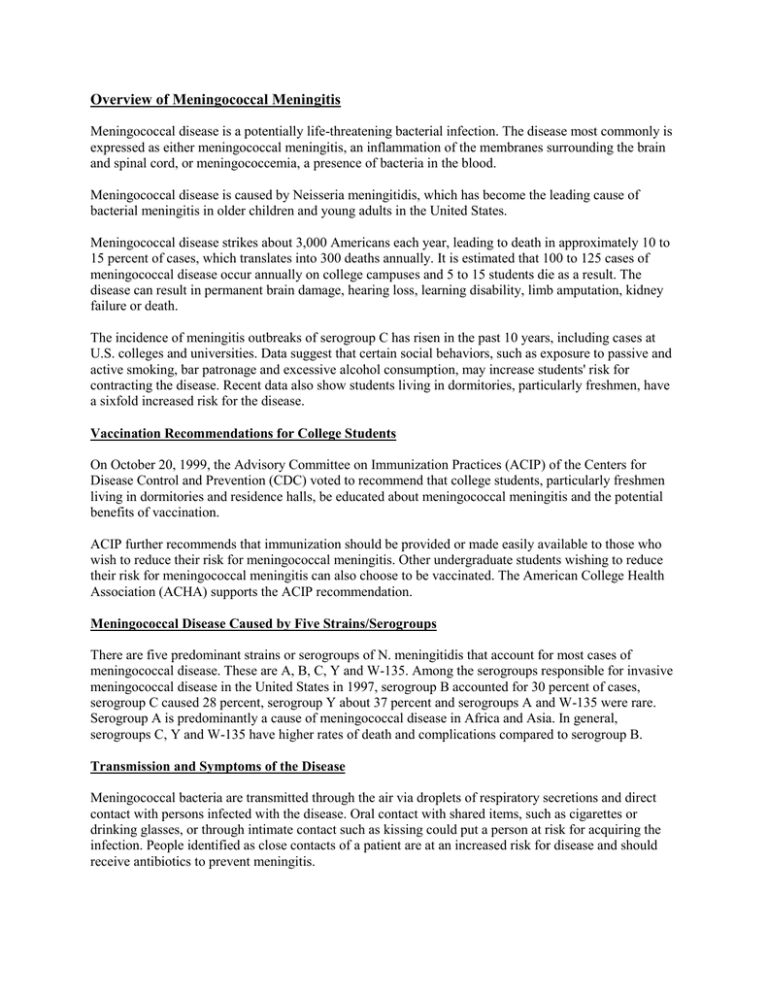
Overview of Meningococcal Meningitis Meningococcal disease is a potentially life-threatening bacterial infection. The disease most commonly is expressed as either meningococcal meningitis, an inflammation of the membranes surrounding the brain and spinal cord, or meningococcemia, a presence of bacteria in the blood. Meningococcal disease is caused by Neisseria meningitidis, which has become the leading cause of bacterial meningitis in older children and young adults in the United States. Meningococcal disease strikes about 3,000 Americans each year, leading to death in approximately 10 to 15 percent of cases, which translates into 300 deaths annually. It is estimated that 100 to 125 cases of meningococcal disease occur annually on college campuses and 5 to 15 students die as a result. The disease can result in permanent brain damage, hearing loss, learning disability, limb amputation, kidney failure or death. The incidence of meningitis outbreaks of serogroup C has risen in the past 10 years, including cases at U.S. colleges and universities. Data suggest that certain social behaviors, such as exposure to passive and active smoking, bar patronage and excessive alcohol consumption, may increase students' risk for contracting the disease. Recent data also show students living in dormitories, particularly freshmen, have a sixfold increased risk for the disease. Vaccination Recommendations for College Students On October 20, 1999, the Advisory Committee on Immunization Practices (ACIP) of the Centers for Disease Control and Prevention (CDC) voted to recommend that college students, particularly freshmen living in dormitories and residence halls, be educated about meningococcal meningitis and the potential benefits of vaccination. ACIP further recommends that immunization should be provided or made easily available to those who wish to reduce their risk for meningococcal meningitis. Other undergraduate students wishing to reduce their risk for meningococcal meningitis can also choose to be vaccinated. The American College Health Association (ACHA) supports the ACIP recommendation. Meningococcal Disease Caused by Five Strains/Serogroups There are five predominant strains or serogroups of N. meningitidis that account for most cases of meningococcal disease. These are A, B, C, Y and W-135. Among the serogroups responsible for invasive meningococcal disease in the United States in 1997, serogroup B accounted for 30 percent of cases, serogroup C caused 28 percent, serogroup Y about 37 percent and serogroups A and W-135 were rare. Serogroup A is predominantly a cause of meningococcal disease in Africa and Asia. In general, serogroups C, Y and W-135 have higher rates of death and complications compared to serogroup B. Transmission and Symptoms of the Disease Meningococcal bacteria are transmitted through the air via droplets of respiratory secretions and direct contact with persons infected with the disease. Oral contact with shared items, such as cigarettes or drinking glasses, or through intimate contact such as kissing could put a person at risk for acquiring the infection. People identified as close contacts of a patient are at an increased risk for disease and should receive antibiotics to prevent meningitis. Many normal healthy people become carriers of these bacteria and usually nothing happens to the person other than developing natural antibodies. Very rarely, for reasons such as suppressed immunity or concurrent respiratory illness, the bacteria invades the body, causing disease. Meningococcal disease usually peaks in late winter and early spring. The disease can easily be misdiagnosed as something less serious, because symptoms are similar to the flu. The most common symptoms include high fever, headaches, stiff neck, confusion, nausea, vomiting, lethargy and/or rashes. Anyone with similar symptoms should contact a physician immediately. If untreated, often within hours of the onset of symptoms, the disease can progress rapidly and can lead to shock and death. Incidence of Meningococcal Meningitis In the United States, outbreaks of serogroup C meningococcal disease have been occurring more frequently since the early 1990s, especially among young adults in school and community settings. There were 26 outbreaks between 1994 and 1996; four of these outbreaks were at a college or university, compared with only 15 outbreaks occurring between 1989 and 1993, including two outbreaks at a college or university. Persons at Risk for the Disease, Including College Students Meningococcal disease can affect people at any age. Certain groups are at increased risk for contracting the disease including those in close contact with a known case, individuals with compromised immune systems and persons traveling to endemic areas of the world. Since 1991, cases of meningococcal disease among 15- to 24-year olds have more than doubled. Recent evidence found that students residing in dormitories on campus appear to be at higher risk for meningococcal disease than college students overall. Further research recently released by the CDC shows freshmen living in dormitories have a six times higher risk for meningococcal disease than college students overall. Prior to 1971, the military had experienced high rates of meningococcal disease, particularly serotype C disease. The U.S. military now routinely vaccinates new recruits. Similar to college students, military recruits live in confined areas. Since the initiation of routine vaccination of recruits, there has been an 87 percent reduction in sporadic cases and a virtual elimination of outbreaks of invasive meningococcal disease in the military. Vaccination to Prevent Meningococcal Meningitis A quadrivalent meningococcal vaccine is available against four of the most common strains of N. meningitidis in the United States (A, C, Y, W-135). The vaccine can be used in adults and children older than two years of age and is 85 to 100 percent effective in preventing serogroups A and C of meningitis in older children and adults. The vaccine is often used to control serotype C meningococcal disease outbreaks and for pre-exposure among certain high-risk groups (e.g., immunosuppressed, travelers). As of October 20, 1999, ACIP recommends that undergraduate college students, particularly freshmen who live in or plan to live in dormitories or residence halls, receive information about meningococcal meningitis and the benefits of vaccination. Freshmen and other undergraduates who wish to reduce their risk for disease should be provided access to the vaccine. Cases/Outbreaks of the Disease Between 1986 and 1993, an outbreak was defined as five cases of the same serotype in 100,000 people with at least three occurring within three months. From 1994 to present, 10 cases of the same serotype in 100,000 people with at least three occurring within three months constitute an outbreak. The vast majority of disease occurs as sporadic and isolated cases, referred to as endemic disease. For More Information For more information on meningococcal meningitis and the vaccine, please contact UW-Stout Student Health Services @ 715/232-1314, Dunn County Public Health @ 232-2388, Red Cedar Clinic @ 2359671 and/or your family physician. You can also visit the websites of the Centers for Disease Control and Prevention (CDC), and the American College Health Association.
